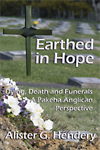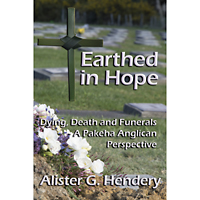Doing Funerals Well
Earthed in Hope:
Dying, Death and Funerals – A Pakeha Anglican Perspective
By Alister G. Hendery
Published by Philip Garside Publishing Ltd
 Review by Anne Priestley, published in Tui Motu InterIslands Oct 2015
Review by Anne Priestley, published in Tui Motu InterIslands Oct 2015
“A quick scan of death notices in a newspaper reveals the fading influence of Christian faith in this country. Many funerals now are held at a crematorium or a funeral director’s chapel. Some of these funerals will be taken by a minister of religion; but increasingly funeral directors and celebrants have taken over the traditional roles of a minister of the church. We live in a world where there are multiple views on “what comes next” after death, mostly at variance with the theological witness of scripture. Even church funerals often celebrate the life which has ended, rather than proclaiming Christian hope in the midst of grief and death.
This is the terrain surveyed by Hendery, a Pakeha Anglican priest. His writing is marked deeply by his trust and hope in God’s grace and equally by his long pastoral experience.
He begins with sociology and theology, chapters which are most lively when earthed in contemporary New Zealand practice. The second half of this book has a strong practical bent, as Hendery discusses pastoral and liturgical issues in journeying with the dying person and in the stages before, during and after the funeral service. He includes thoughtful commentary on the rich resources of A New Zealand Prayer Book /He Karakia Mihinare o Aotearoa, the Anglican prayer book (this material, valuable for Anglican ministers, will be less useful to others). Here, as elsewhere, he provides ideas from a wide range of religious and cultural sources.
Hendery pays attention to the complexities arising from a death by suicide and to special questions concerning children and death. He is not afraid to criticise the Church for less than helpful theology and practice, both past and present.
Hendery’s theological commitments and generous pastoral instincts stand in unresolved tension — the tension of God beyond and God within. For me, this reflects a great challenge of funeral ministry: how to speak the language of the bereaved, in our changed and changing world, and also to proclaim faithfully the good news of God.
I also appreciated Hendery’s determination to be blunt. To say the words “die”, “death”, “coffin”. To face the fact of one’s own death. To accept that, facing death, we do not know everything.
This wise and wonderfully comprehensive book about funeral ministry in Aotearoa is not a quick read, but will benefit many who carry pastoral responsibilities.”

